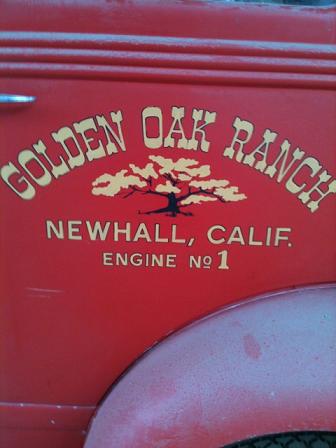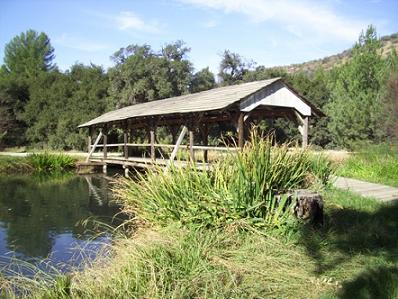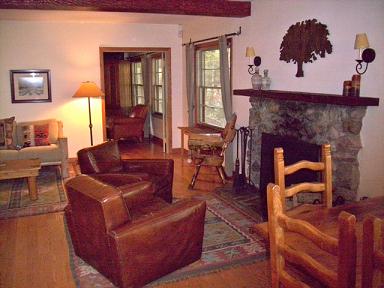Our Film of the Month for January has been called “the best Disney live-action feature that you’ve never seen” by film writer Karl Holzheimer—Third Man on the Mountain. As Walt began producing more and more live-action films and television programs, he continued his innovative thinking—even to the extent of starting his own “movie ranch.” Disney Historian and Museum Member Joseph Titizian wrote this story about the famed filming location for dozens of Disney live-action films, exclusively for Storyboard.
 According to legend, in 1842, seven years before California’s famous gold rush, a rancher named Francisco Lopez fell asleep beneath a large oak tree on his Placerita Canyon ranch and dreamed of finding gold. When Lopez awoke, he pulled up wild onions to eat that were growing underneath the oak and found gold nuggets in the roots of the onions. This discovery set off California’s first gold rush, and for two years prospectors flocked to the canyon to seek their fortunes but the gold soon ran out and the canyon returned to its rural state.
According to legend, in 1842, seven years before California’s famous gold rush, a rancher named Francisco Lopez fell asleep beneath a large oak tree on his Placerita Canyon ranch and dreamed of finding gold. When Lopez awoke, he pulled up wild onions to eat that were growing underneath the oak and found gold nuggets in the roots of the onions. This discovery set off California’s first gold rush, and for two years prospectors flocked to the canyon to seek their fortunes but the gold soon ran out and the canyon returned to its rural state.
Walt Disney’s Golden Oak Ranch is named for this famous tree. The official “Oak of the Golden Dream” designated as California Historical Landmark #168, can be found at Placerita Canyon State Park, located next to the Golden Oak Ranch, 30 miles from The Walt Disney Studios in Newhall, California.
Walt Disney Productions leased the ranch in the summer of 1955 to film the “Spin and Marty” serials for The Mickey Mouse Club. “Spin and Marty” filmed for three years at the Ranch, from 1955 to 1957. Most of the Triple-R’s wooden structures are long gone, but a few, including the blacksmith shop and cattle barn, remain to this day.
Prior to purchasing the Golden Oak Ranch, Walt Disney Productions traveled long distances to do location shooting for their live-action films, but with the addition of television shows, it became necessary to find a more economical location site close to the Studio. With the upcoming production of the “Swamp Fox” series (1959-1961), Disney decided to purchase the Golden Oak Ranch. The rugged canyons and oak lined meadows, as well as its proximity to the Studio in Burbank, made the Golden Oak Ranch the perfect place to film Walt’s increasing slate of film and television productions. Many of the movie ranches that other major studios had been using to film their exterior scenes were being sold at that time for development as residential or commercial projects, and Walt Disney feared that motion picture ranches might cease to exist.
On March 11, 1959, Walt Disney Productions purchased the 315-acre Golden Oak Ranch for $300,000. Disney convinced the state highway planners to create an alternate route for the freeway to the north of the Ranch’s ridgeline, ensuring that the freeway and its associated noise would not visually or aurally effect film productions. Disney has continued to buy the surrounding land over the years, increasing the size of the ranch to roughly 900 acres. The Golden Oak Ranch now extends from ridgeline to ridgeline, ensuring that no production will ever be disrupted by power lines, traffic or residential communities.
 The first movie that was filmed on the ranch after Disney purchased it was Toby Tyler, or Ten Weeks with a Circus in 1959. When the set design called for a wooden bridge to be built over the ranch’s creek, Walt insisted that it be built to modern highway standards. Walt’s attention to detail and quality construction continues to pay off as the structure still known as the “Toby Tyler Bridge” continues to be used by the ranch staff and production companies to this day. Countless film and television programs, not only by Disney, but for many other television and film companies have been filmed at the Ranch over the years. The beautiful Spanish hacienda from the 1961 film The Parent Trap used to sit on the shore of the pond that Herbie skimmed across in the 1969 film The Love Bug. The dirt roads that wind through the oak-lined meadows were once used as the road to the town of Passamaquoddy in Pete’s Dragon (1978)—as well as the road that the General Lee would race down in The Dukes of Hazzard television series. The landmark covered bridge over the pond was constructed in 1962 and can be seen in numerous Disney film and television shows ranging from 1966’s Follow Me, Boys! to the modern day ABC hit Desperate Housewives.
The first movie that was filmed on the ranch after Disney purchased it was Toby Tyler, or Ten Weeks with a Circus in 1959. When the set design called for a wooden bridge to be built over the ranch’s creek, Walt insisted that it be built to modern highway standards. Walt’s attention to detail and quality construction continues to pay off as the structure still known as the “Toby Tyler Bridge” continues to be used by the ranch staff and production companies to this day. Countless film and television programs, not only by Disney, but for many other television and film companies have been filmed at the Ranch over the years. The beautiful Spanish hacienda from the 1961 film The Parent Trap used to sit on the shore of the pond that Herbie skimmed across in the 1969 film The Love Bug. The dirt roads that wind through the oak-lined meadows were once used as the road to the town of Passamaquoddy in Pete’s Dragon (1978)—as well as the road that the General Lee would race down in The Dukes of Hazzard television series. The landmark covered bridge over the pond was constructed in 1962 and can be seen in numerous Disney film and television shows ranging from 1966’s Follow Me, Boys! to the modern day ABC hit Desperate Housewives.
 One of the most special locations at the Golden Oak Ranch is Walt Disney’s cozy cabin, officially known as the Guest House. Walt and his family would occasionally stay at the cabin during a production or for a quick getaway. The three- bedroom Guest House has a large patio overlooking the ranch pond and swimming pool nearby, where Walt would entertain friends and celebrity guest like Fred MacMurray, Jane Wyman, and Annette Funicello. The large waterfall that cascades down from the Guest House patio was used for years in the Arrowhead Mountain Spring Water commercials. Though the Guest House has been redecorated since Walt’s time, some of the furniture in the master bedroom, as well as two leather chairs in the living room belonged to Walt. The leather chairs were acquired by the Walt Disney Archives collection in December 2011.
One of the most special locations at the Golden Oak Ranch is Walt Disney’s cozy cabin, officially known as the Guest House. Walt and his family would occasionally stay at the cabin during a production or for a quick getaway. The three- bedroom Guest House has a large patio overlooking the ranch pond and swimming pool nearby, where Walt would entertain friends and celebrity guest like Fred MacMurray, Jane Wyman, and Annette Funicello. The large waterfall that cascades down from the Guest House patio was used for years in the Arrowhead Mountain Spring Water commercials. Though the Guest House has been redecorated since Walt’s time, some of the furniture in the master bedroom, as well as two leather chairs in the living room belonged to Walt. The leather chairs were acquired by the Walt Disney Archives collection in December 2011.
The staff of the Golden Oak Ranch prides itself on continuing Walt’s legacy of conservation and community service. Protecting and maintaining the natural beauty and structures are the top priority for the Golden Oak Ranch staff. The ranch is home to wildlife including rattlesnakes, mountain lions, and countless deer that have become accustomed to the loud noises and lights of a production crew. The grasses and hay that are mowed from the ranch’s meadows are baled and sent to the Circle-D Corral at Disneyland, where they are fed to the equine cast members of the park. A few lucky horses that retired from their jobs at Disneyland now live on the ranch, but the most famous retiree was a horse named Diamond Decorator, better known as Tornado, Zorro’s black horse in the popular television series, who lived at the ranch until his death in the late 1980’s. The ranch maintains a large vegetable garden, some of its various fresh crops going to the commissary of The Walt Disney Studios and the remainder to the Santa Clarita County Food Bank. The recent additions of a residential street with 14 architecturally unique houses as well as a full business district set will ensure that the Ranch continues to be a filming location that is in high demand.
 Walt Disney’s 1959 prediction has unfortunately come true, and The Golden Oak Ranch has become practically the only surviving movie ranch in Southern California. His vision to purchase and protect its natural beauty is yet another facet of his legacy, which continues to providing a natural film asset for today’s entertainment industry.
Walt Disney’s 1959 prediction has unfortunately come true, and The Golden Oak Ranch has become practically the only surviving movie ranch in Southern California. His vision to purchase and protect its natural beauty is yet another facet of his legacy, which continues to providing a natural film asset for today’s entertainment industry.
[Many thanks to Ranch Manager Steve Sligh, Thamra O’Kray, Jon Wearley and “Garcia” Guerrero (who has worked at the ranch since 1963) for their hospitality on my visit to the Golden Oak Ranch. JT]

Joseph Titizian is an inaugural member of The Walt Disney Family Museum volunteer team. He is a regular contributor to this blog, and has developed continued education courses for the volunteer team. A lifelong Disney fan, Joseph has previously worked at Disneyland Park and Pixar Animation Studios.
Third Man on the Mountain screens daily through January at 1:00pm and 4:00pm (except Tuesdays, and January 21 and 29). Tickets are available at the Reception and Member Service Desk at the Museum, or online by clicking here.
Images above: 1) Fire Truck Door at the Golden Oak Ranch. 2) Perhaps the most frequently-seen Ranch landmark, the Covered Bridge. 3) Often called "Walt's Cabin" this cozy hideaway is officially known as the Guest House. 4) The interior of the Guest House.
